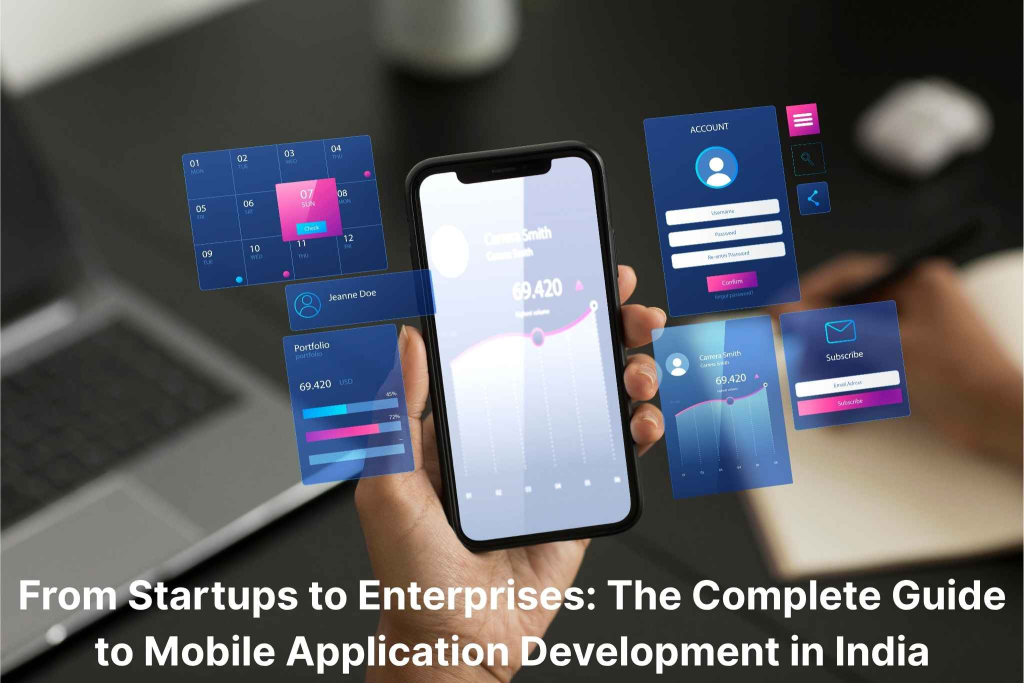Mobile applications have evolved from “nice-to-have” bolt-on platforms to business-critical channels that are fuelling engagement, revenue, and long-term customer loyalty. This has been particularly dramatic in India. With more than 750 million smartphone users and one of the world’s fastest growing app economies, mobile is the default delivery channel for digital engagement across industries.
From startups developing their first minimum viable product (MVP) to large enterprises digitizing their complete business processes, mobile applications are at the heart of digital transformation. This long-form guide delves into the mobile application development in India landscape – exploring the ecosystem, development process, costs, challenges, trends, and how startups and enterprises can thrive when they partner with the right mobile application development services in India.
India’s Mobile Revolution
India has emerged as one of the most fertile mobile application adoption grounds thanks to the following converging factors:
- Huge User-base: India sees 14% of app downloads globally in 2024 (Data.ai)
- Accessible devices: Entry-level smartphones are available for as low as $100, which expands the access.
- Cheap data plans: India has some of the cheapest mobile data plans anywhere in the world, thanks to telecom price wars.
- Digital first Economy: In 2023, UPI saw transactions of over 10 billion/month and interconnects well with mobile apps.
This combination has made an environment in which mobile-first experiences are no longer a choice – they’re a rule.
Who Is Building Apps in India?
The mobile application development in India ecosystem is diverse and rich:
- Freelancers & indie developers: Suitable for lightweight apps or prototypes or proof-of-concept projects.
- Boutique agencies: Specialize in apps that are design-heavy consumer apps and MVP launches.
- Mid-size IT providers: Provide comprehensive delivery, strong project management and technical skills
- Huge IT consultancies: Deal with enterprise-level mobile platforms that have worldwide compliance and scale.
Also, many international organisations have created development centres (GDCs) in India as a result of the availability of quality talent and cost-effectiveness.
The Types of Mobile Apps

Knowing the types of apps is essential before starting the development:
- Native Apps: Developed using Kotlin/Java (Android) or Swift (iOS). They offer the best performance and deep integration but they need separate builds.
- Cross platform apps: Created using React Native or Flutter. iOS and Android can share the same code, which makes it faster to develop and less costly.
- Progressive Web Apps (PWAs): Web apps that have app-like functionality, offline capabilities and can be installed. Cost-effective and scalable.
- Hybrid App: A native shell for web applications. Low performance, but deployed quickly.
The App Lifecycle Development Process
Discovery & Research
The first step is the knowledge of the user. Who are they? What devices do they use? What problem is the app going to solve?
While enterprises disclaim the value of competitive benchmarking, startups stress on integration with existing systems.
Defining the MVP
Production is frequently sold in batches which can result in waste. Instead, make your focus a Minimum Viable Product (MVP) that addresses the biggest need of the users.
Design & Prototyping
The app should be intuitive and this is where you can use wireframes, user flows and high fidelity prototypes to make it so. In India multilingual design and regional UI preferences is key.
Development
Choosing between native and cross-platform is a matter of performance, budget and time. Modern stacks include:
Frontend: Swift, Kotlin, Flutter, React native
Backend: Node.js, Python, Java or Serverless (AWS lambda, Azure functions)
Databases: MySQL, MongoDB, Firebase
Testing
Testing to ensure the application works across India’s fragmented device ecosystem – from high-end iPhones to entry-level Android phones.
Deployment
Publishing to Google Play Store and Apple App Store: Publishing to the app stores requires adhering to compliance and security checks and signing the apps.
Maintenance & Iteration
Post-launch, apps require constant monitoring, bug fixes and feature additions. User feedback is key to driving future iterations
India-specific considerations
- Network conditions: A lot of users are on 3G/4G with speeds up and down. Offline mode and caching are extremely important.
- Device diversity: Apps should work fine on low-RAM devices (2-3 GB)
- Payments: Should integrate with UPI, PayTM, PhonePe and wallets.
- Localization: There are 22 official languages of India. Regional support helps to increase adoption.
- Data Privacy: Data privacy is a growing concern, with India’s Digital Personal Data Protection Act (DPDP Act, 2023) being mandatory.
Cost of developing a mobile app in India
The costs are quite variable depending on complexity, but India is a cost effective destination:
Basic MVP (freelancer/small team): $5000-$20,000
Mid-complexity app (agency): $20,000-$100,000
Enterprise-level application: $100k+ with integrations and SLAs.
Maintenance costs are generally considered 15-25% of the initial build cost per year.
Security & Compliance
Mobile apps that process payments, medical information or business data must adhere to strict standards:
- Secure authentication (OAuth2 and JWT Authentication)
- Encryption (AES, TLS)
- Data localization keeping in mind Indian regulations
- Routine vulnerability penetration testing
Companies require adherence to ISO 27001, SOC2, industry-specific regulations such as HIPAA for healthcare, etc.
Startups vs Enterprises: The Difference Between the Two
Startups
- Prioritize speed-to-market.
- Cross platform frameworks can be used to achieve fast iteration.
- Give priority to analytics and retention.
- Cloud native architectures keep infrastructure lean at minimum.
Enterprises
- Prioritize security, and governance
- Require integrations to the legacy systems (ERP, CRM)
- Develop in-house mobile Centers of Excellence (CoEs).
- Work with suppliers that provide 24/7 SLAs and support around the world
Selecting a Mobile Development Partner in India

Key evaluation criteria:
- Domain & market knowledge
- Development methodologies (CI/CD, testing frameworks).
- Communication & cultural fit
- Help maintain models and SLA commitments
- References & client testimonials
Many organizations choose to work with specialized mobile application development services India for cost efficiency and scalability.
Success metrics
Download is not a way to measure success. Important metrics include:
- Retention rates (D1, D7, D30)
- User engagement time
- Conversion funnel: how does it work?
- Crash-free sessions
- Net Promoter Score (NPS)
Industry Case Studies
Zomato
From a simple restaurant discovery platform, to building a global food delivery powerhouse using app-first approach, personalisation and deep integration to payments.
Paytm
From a mobile recharge app to a super-app which has payments, banking, insurance, and ticketing. Paytm has utilized the digital payment revolution in India.
Byju’s
Tap into India’s edtech boom to take education beyond classrooms with interactive mobile learning
What these case studies demonstrated is how Indian companies leveraged mobile applications not only as distribution channels, but as actual business models.
Industry quotes from industry experts,
Sundar Pichai (Google): “We have moved from a mobile first to an AI first world.” This makes mobile the bedrock for new technologies such as AI.
Satya Nadella (Microsoft): “It is not the device that’s mobile. It is you.” It is also about a user experience over hardware.
Jeff Bezos (Amazon): “The biggest single thing: Obsessively focused on the customer.”
TAV Tech Solutions: Balancing performance, speed, and relevance: Building for mobile-first in India We build for different devices, dynamic networks and unique user behavior – making sure apps don’t just launch, they flourish.
Future Trends in Mobile Apps Development in India
- Personalized experiences: Chatbots, personalization, predictive analytics.
- 5G adoption: Enabling AR/VR, low latency gaming and HD streaming.
- Super apps: Integrating many services within a single platform
- Data privacy focus: Increased compliance requirements under India’s DPDP Act
- Decentralized apps (dApps): Emergence of blockchain based financial and utility applications.
- Voice & vernacular: Increasing access by voice search and geographical languages.
- IoT integration: Smart homes, connected health trackers, connected vehicles
Business Checklist for Health and Safety
- Creating user personas and regional requirements.
- Native, cross platform or PWA depends on the goals
- The design should be network variable and device variety.
- Support Payment through UPI and local wallet
- Arrange for multi-lingual support.
- Allocations for continual updates and operations.
- Pick a Partner that has good references and industry experience.
- Adopt analytics from day one.
Final thoughts
The history of mobile application development in India is a history of scale, variety, and creativity. These include low cost rapid experimentation for startups, and the opportunity for enterprises to tap into the talent base in India to scale mission critical mobile platforms.
Whether you’re a startup validating an idea or an enterprise driving operation changes, it all comes down to understanding your users, selecting the right technology, and collaborating with the right mobile application development services in India.
As TAV Tech Solutions emphasizes, not only is it important to build in India but to build experiences that will last.
With a customer-centric approach, continuous iteration, and a deep understanding of the local context, businesses can tap into the immense potential of India’s mobile-first economy.




















